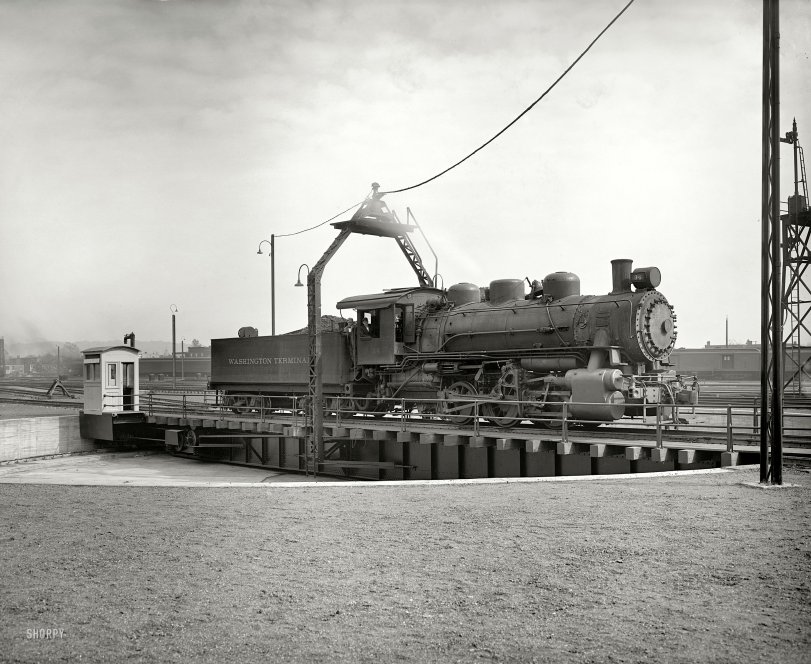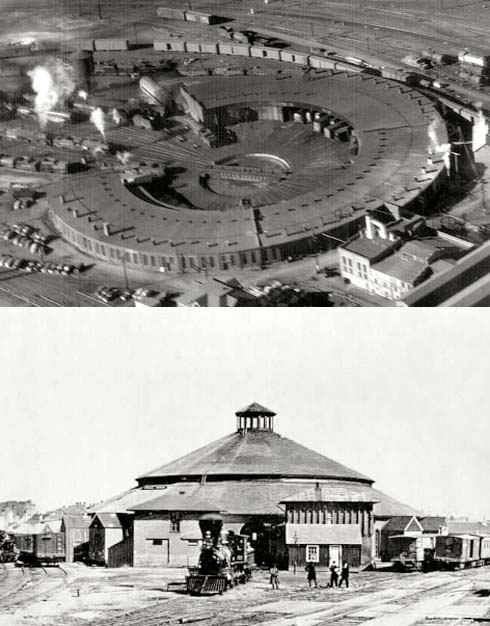


Framed or unframed, desk size to sofa size, printed by us in Arizona and Alabama since 2007. Explore now.
Shorpy is funded by you. Patreon contributors get an ad-free experience.
Learn more.

- Texas Flyer wanted
- Just a Year Too Soon
- WWII -- Replacing men with women at the railroad crossing.
- Yes, Icing
- You kids drive me nuts!
- NOT An Easy Job
- I wonder
- Just add window boxes
- Icing Platform?
- Indiana Harbor Belt abides
- Freezing haze
- Corrections (for those who care)
- C&NW at Nelson
- Fallen Flags
- A dangerous job made worse
- Water Stop
- Passenger trains have right of way over freights?
- Coal
- Never ceases to amaze me.
- Still chuggin' (in model form)
- Great shot
- Westerly Breeze
- For the men, a trapeze
- Tickled
- Sense of loneliness ...
- 2 cents
- Charm City
- What an Outrage
- Brighton Park
- Catenary Supports
Print Emporium
Iron Horse: 1923

Washington, D.C., circa 1923. "Bethlehem Steel -- Washington Terminal Co." National Photo Company Collection glass negative. View full size.
Lots of PRR influence in this TT.
There are lots of Pennsylvania Railroad influence on this brand new turntable. Notice the PRR standard 2 pipe railing stanchions, and the power arch. I love the PRR standard yard lamps with the ? shaped mounts. The switcher may be USRA but it has a PRR headlight and tender lamp. Maybe someone can research this and see if it was carried on the PRR roster as a leased unit.
Not surprising. The PRR was one of the owning roads that shared the WT.
Still goin' 'round!
I work at the Morris Park facility of the Long Island RR. The place dates to the late 1800's and yes we still have a turntable and a roundhouse, both in regular use.
Washington Terminal Operations
I would guess this photo was taken at the Ivy City yards looking eastward. The rise in the background could either be Brentwood or Mt. Olivet. Dave, not all turntables were located inside roundhouses. Often the roundhouse circled around the turntable but the turntable itself was not covered. An example is the still-functioning roundhouse and turntable at the Steamtown National Historic Site, Scranton Pa.
[The turntable is in the roundhouse. The roundhouse goes around the turntable. Moving right along. - Dave]
Was this a turntable solely for "heading" engines or is the photo taken after the first stage of a construction project which would see a new roundhouse and radiating tracks added around this turntable?
Washington Post, Jan 13, 1947.‘Fire-Knocker Horses’ Have Hefty Job at D.C. Roundhouse.
The Washington Terminal roundhouse here abounds in “fire-knocker horses,” and if you find that confusing, you should visit the place. Located near 12th and New York ave. ne., it is a lustly, bustling, smoke-ridden place where whistles hoot and the smell and sound of railroading is in the air.
With the greatest of ease they are currently giving some 200 locomotives a “going over” daily, and during the holiday season the upper the ante by about 40. That means they are often shunting the big engines out every few minutes, ready to highball over the hills and far away.
Boucher Explains ‘Huffin’ and Puffin’’
Edward F. Boucher, who bosses the place, a railroader for 42 years, and there since the place opened on November 11, 1907, yesterday explained what the Huffin’ and Puffin’ was all about.
First you must realize that when a train comes into the city, whether from the Pennsylvania, Baltimore & Ohio, the Southern, the Richmond, Fredericksburg & Potomac of the Chesapeake & Ohio, after the passengers are unloaded, the engineer still has a few chores to do.
And, incidently, he isn't really an engineer, says Boucher, but an “engiineman,” pronounced “in-jine-man,” not to be confused with either the “inside” or “outside hosteler.”
The big locomotive rolls from Union Station northwards, passing through the “T street coach yards” to the “Ivy City Engine House Yards,” near the roundhouse.
First Stop is at Inspection Pits
First stop is at the “inspection pits” where four inspectors clamber aboard. The “in-jine-man,” fills out a form telling any defects he may know about which developed during his trip, then he checks out.
As required by law, the inspectors mark other items that need to be fixed on the same form. Boucher says that almost all the locomotives need some “running repairs” when they come in, tightening up and so on. Others need major overhauls from time to time.
With an “outside hosteler” at the throttle, the engine moves from the inspection pits down to the “fire tracks” where the “fire knocker horses” take over.
These oddly named men, in the case of steam engines, “clean or draw” the fire. When a fire is “drawn” it is “knocked out,” and when it is “cleaned,” it is about the same as cleaning your own furnace.
Horses Put on Coal by Gravity
All this goes on over what is called the “ash pits.” Next stop is the “coal wharf,” where the “fire knocker horses” put on an average of six of seven tons of coal aboard the locomotive by a gravity device which does the job in about five minutes. The “coal wharf” itself holds 1200 tons.
The tanks are willed with water, anywhere from 8000 to 20,000 gallons, and the locomotive then moves to the turn-table where an “inside hosteler” takes over to move into one of the “engine pits” in an engine house.
Actually there are two turn-tables, each 100 feet long and capable of supporting 300 tons, which take the locomotive aboard and spin it in the direction necessary for it to enter the proper “engine pit” in the roundhouse.
25 Engine Pits in Each Roundhouse
The roundhouse itself is divided into two parts, the East roundhouse and the West roundhouse, each with 25 engine pits. Around 400 men, representing every trade and some special ones, like a “rod cup man,” work there.
Inside the roundhouse the giant engines are very much like an automobile over a grease-pit. There they are lubricated and repairs are made. Once repaired and marked up as “ready for a run,” the engine moves out of the roundhouse, on to the turntable, where it is “headed” and placed on a “ready track,” from which it goes back up the yards to where its train is being made up.
Electric trains follow the same general principles. However, because they may operate from either end, there is no need for them to visit the roundhouse, except in the case of major repairs.
Not inside
Dave, the turntable wouldn't be inside the roundhouse. Picture a roundhouse as part of a circle (an arc at the perimeter of a circle). The turntable would be located at the center point of the circle.
[In other words, "in the roundhouse." The same way football players play "in a stadium." The roundhouse includes the turntable, which can be covered or not. - Dave]

Put them on the pit
Turntables have long been a thing of the past, as is the routine need to turn an engine. As a practical matter, steam locomotives usually only ran nose first, which frequently required a locomotive to be "turned" before being sent down the main. (An exception was the B & O practice of running their locomotives backward through tunnels out east, to spare the head-end crew the effects of breathing trapped engine smoke.) Most power consists today have engines on each end facing opposite directions, so no matter what the assignment, a controlling engine will be "first out," pointed forward. In the rare event a engine needs to be turned, they're usually passed through a wye.
Bethlehem is the brand
This is obviously a shiny, new turntable; it doesn't show any dirt, let alone grease or rust.The pit looks like newly-cured concrete. WT's number 34 may well be the first hog to ride this table.
This table is electric powered; note the power source above the center of the bridge. The mechanism is under the operator's cabin.
Washington Terminal has had at least two turntables in modern times, and I'm trying to figure out which this is. One was located at Ivy City, site of WT's engine facility; the second is almost under the station trainshed. I'm betting this is the latter, though it looks quite different without the former Railroad Express building which would be along the background today.
Oh, this is likely a Bethlehem Steel turntable, and Washington Terminal is today operated by Amtrak.
[Washington Terminal was the company that owned and operated Union Station. Bethlehem Steel was the client that commissioned the photo. - Dave]
Spinning on the big wheel
Love the train photos - thanks Dave. Did a little looking around - this is probably one of 255 0-6-0 switcher locomotives built to USRA specifications starting in 1916. Washington Terminal received three. The man in the loco driving seat is most likely not the engineer, but the hostler who moved locomotives at roundhouse turntables.
Spot the sign
Excellent venue to advertise Coca-Cola!
Dressed for the job!
Love how the fireman is dressed with overalls and and a bowtie! People took their jobs seriously back then.
Word Choices
What's an "iron" horse doing in a steelyard?
[The yard is Union Station in Washington. - Dave]
Really Clean
Did they give the turntable operators shack a coat of paint just for this photo? The gravel area in the foreground looks to have been groomed for the photo too. In today's world I would expect to see a lot of clutter and trash.
[It looks fresh because it's new. - Dave]
USRA switcher
This is a USRA (United States Railroad Administration) standard design from World War I. Still available as a model.
























On Shorpy:
Today’s Top 5